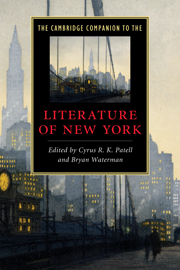Book contents
- Frontmatter
- Introduction
- 1 From British outpost to American metropolis
- 2 Dutch New York from Irving to Wharton
- 3 The city on stage
- 4 Melville, at sea in the city
- 5 Whitman’s urbanism
- 6 The early literature of New York’s moneyed class
- 7 Writing Brooklyn
- 8 New York and the novel of manners
- 9 Immigrants, politics, and the popular cultures of tolerance
- 10 Performing Greenwich Village bohemianism
- 11 African American literary movements
- 12 New York’s cultures of print
- 13 From poetry to punk in the East Village
- 14 Staging lesbian and gay New York
- 15 Emergent ethnic literatures
- Further reading
- Index
- Series list
12 - New York’s cultures of print
Published online by Cambridge University Press: 28 November 2010
- Frontmatter
- Introduction
- 1 From British outpost to American metropolis
- 2 Dutch New York from Irving to Wharton
- 3 The city on stage
- 4 Melville, at sea in the city
- 5 Whitman’s urbanism
- 6 The early literature of New York’s moneyed class
- 7 Writing Brooklyn
- 8 New York and the novel of manners
- 9 Immigrants, politics, and the popular cultures of tolerance
- 10 Performing Greenwich Village bohemianism
- 11 African American literary movements
- 12 New York’s cultures of print
- 13 From poetry to punk in the East Village
- 14 Staging lesbian and gay New York
- 15 Emergent ethnic literatures
- Further reading
- Index
- Series list
Summary
Pluralities of print
Where to begin a discussion of “New York's cultures of print”? A logical starting point might be the national magazines founded in the city around the turn of the nineteenth century, large-format monthlies like Munsey's (1889-1921), Collier's (1888-1919), and McClure's (1893-1911). These popular publications drew on New York's cutting-edge publishing technology and marketing savvy, as well as on the city's wealth of journalistic talent, to help bring into being a national middle-class reading public. Their inheritors were the “smart” magazines of the 1920s and 30s - Smart Set (1900-30), Vanity Fair (1913-36), The New Yorker (1925-present), and Esquire (1933-present) - dedicated to bringing New York's culture and style to the hinterlands. Significantly, these publications began the segmentation of the national public by targeting a niche audience with high education and income levels for the advertisers of luxury goods.
To get the full flavor of New York's cultures of print, however, we should juxtapose these frankly commercial endeavors with their more bohemian counterparts. Although they were scattered around the US and Europe, plenty of the “little magazines” that shaped the roaring twenties and radical thirties made their homes in New York, including The Dial (a revived and revised version of the Boston Transcendentalist publication of the same name, 1916-29), The Seven Arts (1916-17), The Masses (1911-17), and The New Masses (1926-48). They were succeeded by the Beat and progressive publications that hallmarked the mid-century “mimeograph revolution.” Devoted to journalism, poetry, and other forms of word and print art, downtown publications like Gilbert Sorrentino’s Neon (1956–60), Diane di Prima’s The Floating Bear (1961–68), and Ed Sanders’s Fuck You/a Magazine of the Arts (1962–65) helped to defi ne a downtown print culture that saw itself as aesthetically, economically, and politically distinct from the publishing mainstream ensconced in midtown.
- Type
- Chapter
- Information
- The Cambridge Companion to the Literature of New York , pp. 176 - 188Publisher: Cambridge University PressPrint publication year: 2010

